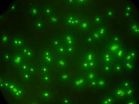(Press-News.org) Immunology: Three percent of the world's population is currently infected by hepatitis C. The virus hides in the liver and can cause cirrhosis and liver cancer, and it's the most frequent cause of liver transplants in Denmark. Since the virus mutates strongly, we have no traditional vaccine, but researchers at the University of Copenhagen are now the first to succeed in developing a vaccine, which provides future hope for medical protection from this type of hepatitis.
"The hepatitis C virus (HCV) has the same infection pathways as HIV," says Jan Pravsgaard Christensen, Associate Professor of Infection Immunology at the Faculty of Health Sciences, University of Copenhagen.
"Approximately one newly infected patient in five has an immune system capable of defeating an acute HCV infection in the first six months. But most cases do not present any symptoms at all and the virus becomes a chronic infection of the liver."
Poorly treated donor blood and dirty needles are sinners
Every year three or four million more people become infected and the most frequent path of infection is needle sharing among drug addicts or tattoo artists with poor hygiene, such as tribal tattoo artists in Africa and Asia. Fifteen percent of new infections are sexually transmitted, while ten percent come from unscreened blood transfusions.
According to Allan Randrup Thomsen, Professor of Experimental Virology, "Egypt is one country with a high incidence of HCV. This is particularly due to lack of caution in the past with regards to screening donated blood for the presence of this virus," he says.
China, Brazil, South East Asia and African states south of the Sahara also have a high incidence, while the disease is also spreading through Eastern Europe, especially Romania and Moldova.
HCV mutates too fast for traditional vaccines
The new vaccine technology was developed by Peter J. Holst, a former PhD student now a postdoc with the Experimental Virology group, which also includes Professor Allan Randrup Thomsen and Associate Professor Jan Pravsgaard Christensen.
The technology works by stimulating and accelerating the immune system, and showing the body's defence mechanisms of the parts of the virus that are more conserved and do not mutate as fast and as often, such as the molecules on the surface of the HCV.
Basically, traditional vaccines work by showing the immune defences an identikit image of the virus for which protection is desired. Antibodies then patrol all entrances with a copy of this image and are able to respond rapidly if the virus attempts to penetrate. But the influenza virus mutates its surface molecules and in the course of a single season it takes on a new guise so that it no longer resembles the original identikit image and the vaccine loses its efficacy.
Professor Randrup explains, "Mutations of the surface are Darwin at work, so to speak. The virus tries to outwit the immune defences and if it succeeds we get ill, and our response is new vaccines."
Associate Professor Pravsgaard Christensen says, "Viruses like HCV mutate so rapidly that classical vaccine technology hasn't a chance of keeping up. But the molecules inside the virus do not mutate that rapidly, because the survival of the virus does not depend on it."
New vaccine technology gives immune system information about virus' stable parts
According to Professor Randrup, the body's natural defences usually don't see these internal virus molecules until the virus has taken residence in the body.
"Our cells constantly show random samples of their contents to the immune defence patrols, and if there are enough foreign bodies among them, the alarm is triggered," says Professor Randrup.
The cells display fragments of the surface molecules and internal genes from the virus, and if you show the immune defences a kind of X-ray of the inner genes, they will respond. Actually, the response is extremely potent, and one of the things it does is summon the specialised CD8 killer cells.
"We took a dead common cold virus, an adenovirus that is completely harmless and which many of us have met in childhood," Associate Professor Pravsgaard Christensen explains.
"We hid the gene for one of the HCV's internal molecules inside it. At the same time we attached a special molecule on the internal molecule so that when the cells of the mouse body tried to take a sample, they would extract a more extensive section. The immune defences would then be presented with a larger section of the molecule concerned. You may say that the immune defences were given an entire palm print of the internal genes instead of just a single fingerprint."
This strategy resulted in two discoveries from the team. Firstly, the mice were vaccinated for HCV in a way that meant that protection was independent of variations in the surface molecules of the virus. Secondly, the immune defences of the mice saw such an extensive section of the internal molecule that even though some aspects of it changed, there were still a couple of impressions the immune defences could recognise and respond to.
The new technology to be tested in monkeys
Another virus that mutates its surface molecules with extreme rapidity is HIV. It changes skin in the space of 24 hours, and like HCV, we do not yet have a cure or a vaccine. The researchers think that HIV originally migrated to man from monkeys in the 1930s, when it was the simian Immunodeficiency virus that still circulates among a number of species of wild African monkeys.
"The Danish Medical Research Council (DMRC) has given postdoc Peter Holst a grant to test our technology for a SIV vaccine for macaque monkeys in the US," says Associate Professor Pravsgaard Christensen.
The University of Copenhagen is also currently negotiating the sale of the patent for the process so that the technology can be developed for use in human vaccines.
The discovery of an effective HCV vaccine has just been published in the Journal of Immunology.
###
Contact
Professor Allan Randrup Thomsen, telephone +45 35 32 78 71 or +45 35 32 78 75, E-mail: athomsen@sund.ku.dk
Associate Professor Jan Pravsgaard Christensen, telephone: +45 35 32 78 73 or mobile: + 45 30 58 99 45, E-mail: jpc@sund.ku.dk
Postdoc Peter Johannes Holst, telephone: 35 32 78 75, E-mail: pholst@sund.ku.dk
New vaccine technology protects mice from hepatitis C virus
2011-02-24
ELSE PRESS RELEASES FROM THIS DATE:
The world's first surfboard with integrated technology
2011-02-24
Pukas Surf (the leading manufacturer and distributor of high-performance surfboards in Europe) and Tecnalia Research & Innovation have presented their research work into the mechanical behaviour of surfboards.
Surfing is still a sport governed by feelings. Most innovations in board design and manufacture, as well as analysis of surfing technique, have been the result of "trial and error" procedures and the experiences of shapers, trainers and surfers. The driving forces behind this joint project aim to "turn feelings into facts and figures" and provide as yet unquantified ...
New hypothesis explains why drugs increase risk of heart attacks and strokes
2011-02-24
CLEVELAND – February 21, 2011 – New research shows that medications which have raised safety concerns over heart attack and stroke risks may not have gotten approval from the Food and Drug Administration (FDA) if the cardiovascular effects of fluid retention had been better understood. Fluid retention may explain the increased risk of heart attacks and strokes of medications such as Vioxx®, Bextra®, and Avandia®.
The research published in Clinical Hemorheology and Microcirculation (IOS Press, ISSN 1386-0291), calculates the effects of fluid retention upon the velocity ...
Prevalence of bunions increases with age; more common in women
2011-02-24
New research determined that an increase in the severity of hallux valgus, or bunion deformity, progressively reduced both general and foot-specific health related quality of life (HRQOL). Bunion deformity was found in 36% of the study population and occurred more frequently in women and older individuals. Pain in other parts of the body beyond the foot was associated with increased bunion severity. Details of this UK population-based study appear in the March issue of Arthritis Care & Research, a journal published by Wiley-Blackwell on behalf of the American College of ...
Parasitic protozoons survive waste water and drinking water treatment plants in Galicia
2011-02-24
"The presence of two resistent forms of protozoons, the oocysts from the Cryptosporidium genus and cysts of the Giardia genus, is one of the greatest public health problems in water supply, because these parasites can easily survive our water treatment systems", José Antonio Castro Hermida, a scientist at the Galician Institute for Food Quality in the Xunta de Galicia (regional government), tells SINC.
A team led by this researcher took 232 water samples in 55 Galician towns, and confirmed the presence of these infectious life forms in waste water treatment plants, drinking ...
Elderly drivers have higher crash rates in non problematic environments than other drivers
2011-02-24
This release is available in Spanish and French.
Drivers aged over 60 have higher crash rates in non problematic operating environments –as in junctions– than drivers of other age groups. Although elderly drivers present deteriorated driving abilities, they have proved to be more cautious, to compensate such deficiencies. This way, older drivers avoid engaging in risky behaviours like speeding, passing dangerously or driving under the effects of alcohol.
Such were the conclusions drawn of the study conducted by University of Granada researchers and recently published ...
Oldest fossils of large seaweeds, worm-like animals tell story of ancient oxygen
2011-02-24
Almost 600 million years ago, before the rapid evolution of life forms known as the Cambrian explosion, a community of seaweeds and worm-like animals lived in a quiet deep-water niche near what is now Lantian, a small village in south China.
Then they simply died, leaving some 3,000 nearly pristine fossils preserved between beds of black shale deposited in oxygen-free and unbreathable waters.
Scientists from the Chinese Academy of Sciences, Virginia Tech in the United States and Northwest University in Xi'an, China report the discovery of the fossils in the Feb. 17 ...
Designing a city for safe protests
2011-02-24
Tel Aviv — Civil protests, from peaceful sit-ins at the Pentagon to violent riots in Cairo, nonetheless share some common characteristics. To study how protests evolve in public spaces, Dr. Tali Hatuka, an architect and head of Tel Aviv University's Laboratory of Contemporary Urban Design, has dissected some of the world's most publicized protests — those in Washington, Istanbul, Tel Aviv, Beijing, and Leipzig.
History shows that protests and civil disobedience are inevitable and necessary expressions of dissent in any democratic nation — and under many authoritarian ...
Researchers achieve a full film frame of a family of proteins essential for cell function
2011-02-24
Researchers at IRB Barcelona have completed the 3D structural sequence adopted by several essential proteins in the exchange of substances between the extra and intracellular milieu. This finding provides a global perspective of the structural changes that occur in these relevant proteins during basic cell processes, such as protein synthesis, the regulation of metabolism and cell volume, and nerve transmission.
The exchange of substances between the intra and extra cellular environment is performed by transporter proteins located in cell membranes. These proteins act ...
A semantic sommelier: Wine application highlights the power of Web 3.0
2011-02-24
Troy, N.Y. – In the restaurant of the future, you will always enjoy the perfect meal with that full-bodied 2006 cabernet sauvignon, you will always know your dinner companions' favorite merlot, and you will be able to check if the sommelier's cellar contains your favorite pinot grigio before you even check your coat. These feats of classic cuisine will come to the modern dinner through the power of Semantic Web technology.
Web scientist and Rensselaer Polytechnic Institute Tetherless World Research Constellation Professor Deborah McGuinness has been developing a family ...
UV-transparent coating for image sensors
2011-02-24
This release is available in German.
They have been used as standard in multimedia electronics for a long time, and now they are making rapid inroads in high performance applications: CMOS image sensors are no longer only used in cell phones and digital cameras. The automotive industry, for instance, has discovered the potential of optical semiconductor chips and is increasingly using them in driver assistance systems – from parking aids and road lane detection to blind-spot warning devices. In special applications, however, the sensors that convert light into electrical ...



